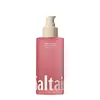What's inside
What's inside
 Key Ingredients
Key Ingredients

 Benefits
Benefits

 Concerns
Concerns

 Ingredients Side-by-side
Ingredients Side-by-side

Helianthus Annuus Seed Oil
EmollientRosa Canina Fruit Oil
EmollientVitis Vinifera Seed Oil
EmollientPrunus Armeniaca Kernel Oil
MaskingSimmondsia Chinensis Seed Oil
EmollientCannabis Sativa Seed Oil
EmollientOlea Europaea Fruit Oil
MaskingCannabis Sativa Flower/Leaf/Stem Extract
AntioxidantMoringa Oleifera Seed Oil
EmollientSqualane
EmollientHelichrysum Italicum Flower Oil
MaskingAdansonia Digitata Oil
EmollientMagnesium Chloride
Citrus Aurantium Dulcis Peel Oil
MaskingLavandula Hybrida Oil
EmollientLitsea Cubeba Fruit Oil
MaskingJuniperus Virginiana Wood Oil
PerfumingPelargonium Graveolens Oil
MaskingApium Graveolens Seed Oil
PerfumingCinnamomum Cassia Leaf Oil
MaskingCitrus Nobilis Peel Oil
MaskingEugenia Caryophyllus Bud Oil
MaskingMentha Viridis Leaf Oil
AstringentPogostemon Cablin Leaf Oil
MaskingCananga Odorata Flower Oil
MaskingIllicium Verum Leaf Oil
MaskingRosmarinus Officinalis Leaf Oil
MaskingCinnamal
PerfumingLimonene
PerfumingEugenol
PerfumingHelianthus Annuus Seed Oil, Rosa Canina Fruit Oil, Vitis Vinifera Seed Oil, Prunus Armeniaca Kernel Oil, Simmondsia Chinensis Seed Oil, Cannabis Sativa Seed Oil, Olea Europaea Fruit Oil, Cannabis Sativa Flower/Leaf/Stem Extract, Moringa Oleifera Seed Oil, Squalane, Helichrysum Italicum Flower Oil, Adansonia Digitata Oil, Magnesium Chloride, Citrus Aurantium Dulcis Peel Oil, Lavandula Hybrida Oil, Litsea Cubeba Fruit Oil, Juniperus Virginiana Wood Oil, Pelargonium Graveolens Oil, Apium Graveolens Seed Oil, Cinnamomum Cassia Leaf Oil, Citrus Nobilis Peel Oil, Eugenia Caryophyllus Bud Oil, Mentha Viridis Leaf Oil, Pogostemon Cablin Leaf Oil, Cananga Odorata Flower Oil, Illicium Verum Leaf Oil, Rosmarinus Officinalis Leaf Oil, Cinnamal, Limonene, Eugenol
Carthamus Tinctorius Seed Oil
MaskingRicinus Communis Seed Oil
MaskingCaprylic/Capric Triglyceride
MaskingParfum
MaskingCaryodendron Orinocense Seed Oil
EmollientAleurites Moluccanus Seed Oil
Skin ConditioningSqualane
EmollientLimnanthes Alba Seed Oil
Skin ConditioningPongamia Glabra Seed Oil
Skin ConditioningMoringa Oleifera Seed Oil
EmollientPrunus Armeniaca Kernel Oil
MaskingPlumeria Acutifolia Flower Extract
Skin ConditioningTetrahexyldecyl Ascorbate
AntioxidantEclipta Prostrata Extract
Skin ConditioningMelia Azadirachta Leaf Extract
Skin ConditioningLinoleic Acid
CleansingLecithin
EmollientPhytosteryl Canola Glycerides
Skin ConditioningPalmitic Acid
EmollientOleic Acid
EmollientTriolein
Skin ConditioningTocopherol
AntioxidantStearic Acid
CleansingBenzotriazolyl Dodecyl P-Cresol
UV AbsorberCoumarin
PerfumingHexyl Cinnamal
PerfumingCarthamus Tinctorius Seed Oil, Ricinus Communis Seed Oil, Caprylic/Capric Triglyceride, Parfum, Caryodendron Orinocense Seed Oil, Aleurites Moluccanus Seed Oil, Squalane, Limnanthes Alba Seed Oil, Pongamia Glabra Seed Oil, Moringa Oleifera Seed Oil, Prunus Armeniaca Kernel Oil, Plumeria Acutifolia Flower Extract, Tetrahexyldecyl Ascorbate, Eclipta Prostrata Extract, Melia Azadirachta Leaf Extract, Linoleic Acid, Lecithin, Phytosteryl Canola Glycerides, Palmitic Acid, Oleic Acid, Triolein, Tocopherol, Stearic Acid, Benzotriazolyl Dodecyl P-Cresol, Coumarin, Hexyl Cinnamal
Ingredients Explained
These ingredients are found in both products.
Ingredients higher up in an ingredient list are typically present in a larger amount.
Moringa Oleifera Seed Oil is the oil expressed from the seeds of Moringa oleifera plant. It is more commonly known as Moringa seed oil.
Moringa seeds have antioxidant, anti-inflammatory, and skin hydrating properties. These seeds are rich in oils, proteins, monounsaturated fats, and tocopherols.
As an emollient, moringa seed oil helps trap moisture in the skin by creating a film on top. This helps keep your skin hydrated and soft.
Many compounds in moringa seed oil are antioxidant and anti-inflammatory. These compounds include Vitamin E. , catechins, ferulic acid, and more.
Another compound found in Moringa seed oil is oleic acid.
Moringa trees are native to the Himalayan mountains.
This ingredient may not be fungal-acne safe.
Learn more about Moringa Oleifera Seed OilThis ingredient is the oil from the apricot.
Apricot Kernel Oil is an emollient and helps soften skin. This is due to its fatty acid components. Some of these fatty acids include linoleic and oleic acid.
This ingredient also has antioxidant properties from Vitamins A, C, and E. Antioxidants help fight free-radicals. Free-radicals are molecules that may damage your skin cells. Besides being antioxidants, these vitamins provide plenty of skin benefits as well.
Learn more about Prunus Armeniaca Kernel OilSqualane is an emollient that helps the skin hold onto moisture. It's an oily liquid that occurs naturally in certain types of fish and plant oils.
Because squalane boosts hydration in the skin, it also comes with plenty of benefits: it is an antioxidant and can help fight free radicals and skin damage. Squalane is also found to have a detoxifying effect when applied.
Squalane comes from squalene, which occurs naturally within the sebum of our skin. It is one of the oils our skin produces to keep itself hydrated. Squalane is the hydrogenated version of squalene and has a longer shelf life.
Research shows that squalane is non-irritating (even at 100% concentration).
In general, it's a fantastic ingredient. It does a great job at hydrating the skin, and it's suitable for those with sensitive skin.
The source of squalane may impact malassezia / fungal acne. This is because olive oil derived squalane can contain impurities such as fatty acids and plant waxes. Sugarcane derived squalane is recommended for anyone with malassezia concerns.
Is squalane vegan?
This depends on the source. Squalane can be derived from both plants and animals. Most squalane used in skincare comes from plants.
Please note: the source of squalane is only known if disclosed by the brand. We recommend reaching out to the brand if you have any questions about their squalane.
Read more about squalene with an "e".
Is squalane an oil?
Squalane is often called an oil, but it’s technically not; it’s a hydrocarbon, meaning it’s only made of carbon and hydrogen, unlike true oils which are triglycerides made of fatty acids and glycerol.
The term “oil-free” isn’t regulated, so companies can define it however they want. Some exclude all oils, while others just avoid mineral oil or comedogenic oils.
While some people avoid oils thinking they cause breakouts, the right kind of oil (or oil-like ingredient like squalane) can actually help balance and hydrate your skin. It’s worth testing out simple oils or squalane to see what works best for your skin.
Learn more about Squalane